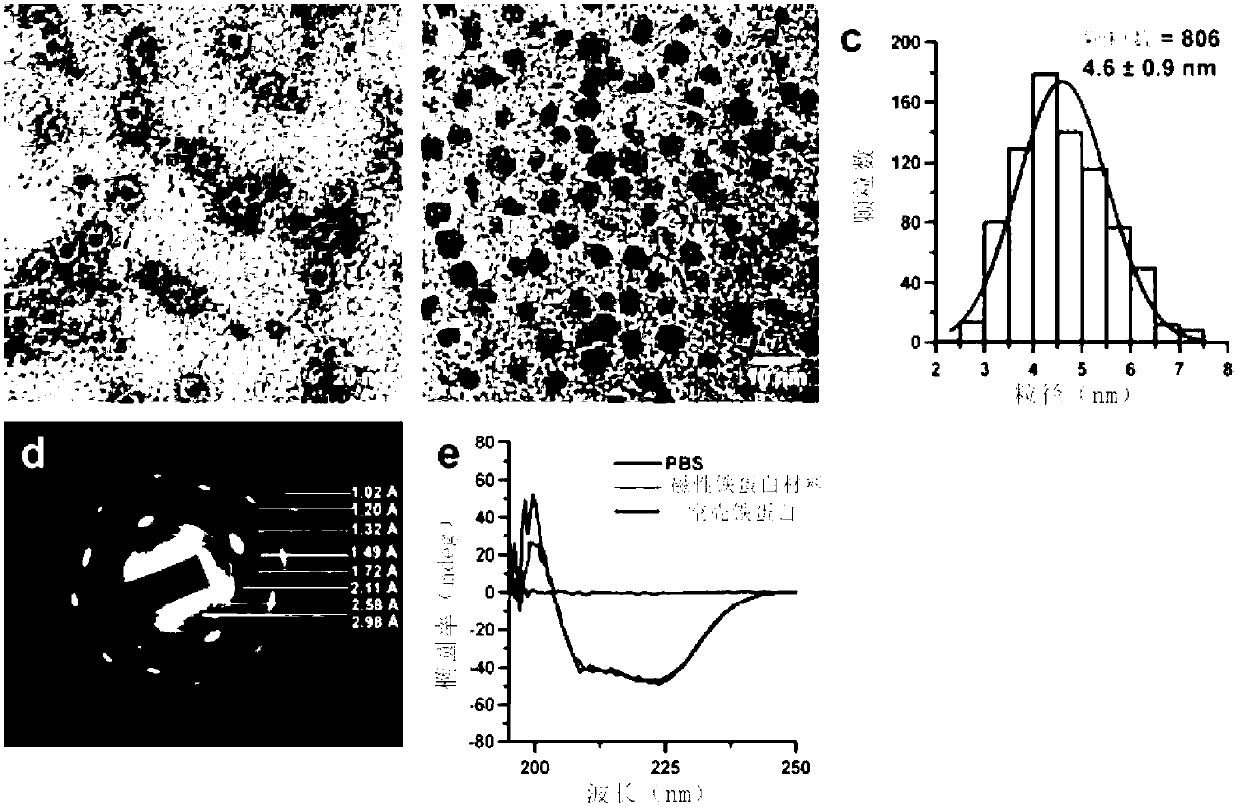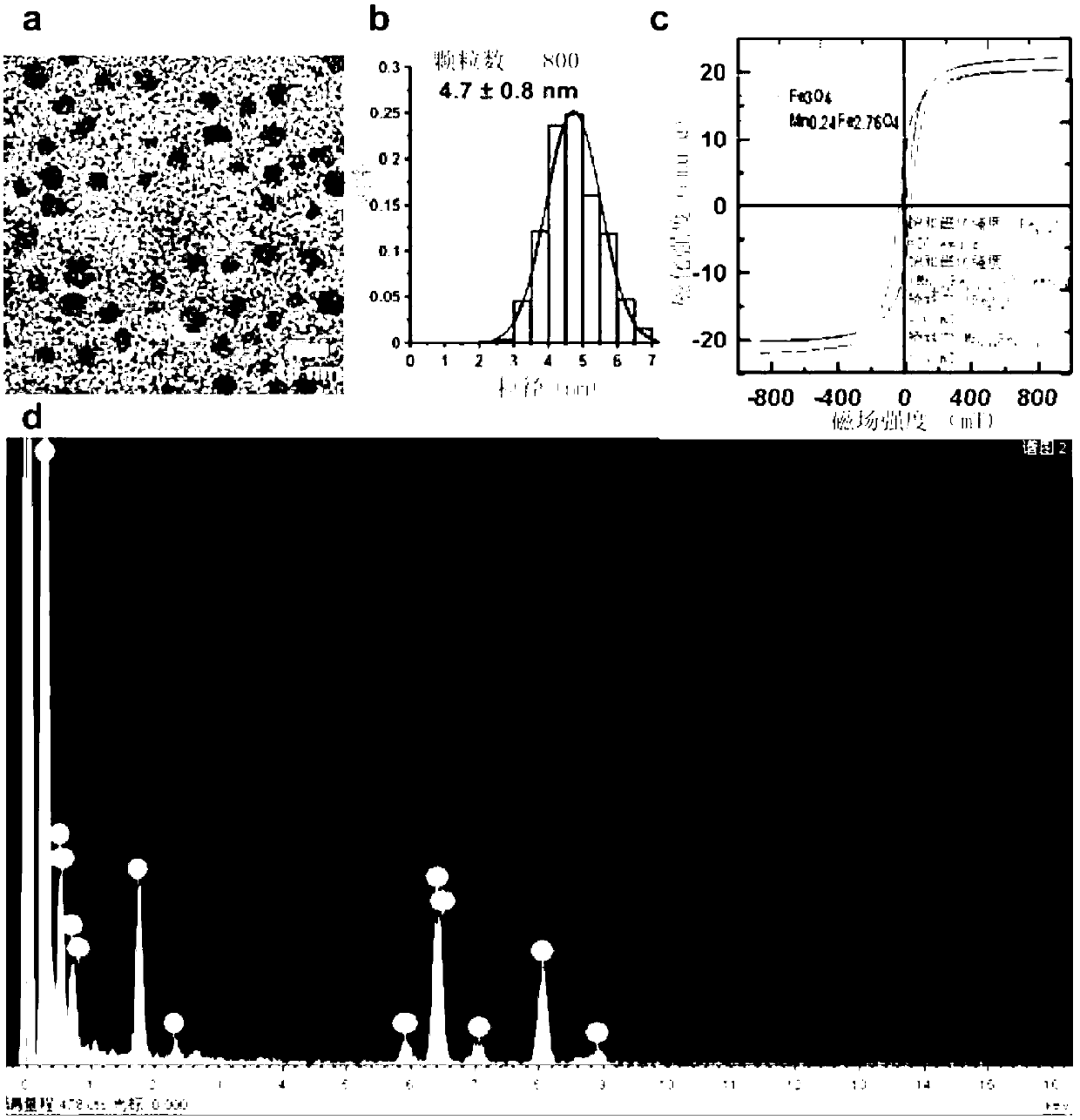Magnetic nano-grade material with cell-targeting property, and biomedical application thereof
A technology of magnetic nanoparticles and derivatives, applied in the direction of medical preparations containing active ingredients, analytical materials, radioactive physical shapes, etc., can solve the problems of not giving full play to the advantages of magnetotactic bacteria
- Summary
- Abstract
- Description
- Claims
- Application Information
AI Technical Summary
Problems solved by technology
Method used
Image
Examples
Embodiment 1
[0144] Biomimetic synthesis of human H subunit magnetic ferritin with intact protein shell conformation
[0145] Using recombinant human ferritin as a template, the full-length cDNA of the H subunit of human ferritin was cloned and constructed on the pET11b plasmid (purchased from Novagen); Plasmids were transformed or co-transformed into bacteria BL21(DE3)pLysS (purchased from Novagen), and IPTG (isopropyl-β-D-thiogalactopyranoside) was added to activate the T7 promoter to induce expression; ultrasound was performed after expression Break up and release the protein; separate and purify the protein; use the purified human H subunit ferritin as a template to combine ferrous salt and oxidant H 2 o 2 Add the solution of recombinant human ferritin to react, control the pH value to 8.5, control the temperature to 65°C, and form strong magnetic nanoparticles inside the recombinant human ferritin; the concentration of ferrous salt is the number of ferrous atoms added each time The ...
Embodiment 2
[0149] Synthesis of magnetic nanomaterials with ferritin-shell-wrapped ferromanganese oxide cores
[0150] Using purified human H subunit ferritin as a template, ferrous salt, manganese salt (the ratio of iron to manganese is 11.5, equivalent to the incorporation of 8% manganese) and oxidant H 2 o 2 Add the solution of recombinant human ferritin for reaction, control the pH value to 8.5, control the temperature at 65°C, and form strong magnetic nanoparticles inside the recombinant human ferritin; finally, the number of iron atoms added to each protein molecule is 4600, manganese The number of atoms is 400; after the reaction is completed, the magnetic particles with complete protein structure are obtained after separation by exclusion chromatography, centrifugation and molecular sieve purification. figure 2 a is an electron micrograph of the ferromanganese oxide nucleus, it can be seen that the formed nucleus is approximately spherical and exhibits good monodispersity; fig...
Embodiment 3
[0152] Biomimetic synthesis of nanomagnetic materials using prokaryotically expressed magnetotactic bacterial membrane protein Mms6
[0153] The whole genome of the magnetotactic bacterium AMB-1 was extracted, the mms6 gene was amplified by PCR, and cloned into the pET15b plasmid (purchased from Novagen). The EcoR I and BamH I restriction sites were used to transform the bacterium BL21(DE3)pLysS ( purchased from Novagen) for prokaryotic expression. The Mms6 protein with His tag was purified by nickel column affinity chromatography. Mix His-Mms6 protein with iron salt solution, adjust the pH to 7-9 with NaOH, react at room temperature for 24 hours to generate hydrated iron oxide compound (ferrihydrite), and then add ferrous salt solution (so that ferrous ions and iron The ratio of ions is 1:2), and continue to react for 24 hours until the color of the solution turns black completely. The obtained magnetic particles are collected by a magnet, washed three times with deoxygenat...
PUM
| Property | Measurement | Unit |
|---|---|---|
| particle size | aaaaa | aaaaa |
| diameter | aaaaa | aaaaa |
| particle diameter | aaaaa | aaaaa |
Abstract
Description
Claims
Application Information
 Login to View More
Login to View More - R&D
- Intellectual Property
- Life Sciences
- Materials
- Tech Scout
- Unparalleled Data Quality
- Higher Quality Content
- 60% Fewer Hallucinations
Browse by: Latest US Patents, China's latest patents, Technical Efficacy Thesaurus, Application Domain, Technology Topic, Popular Technical Reports.
© 2025 PatSnap. All rights reserved.Legal|Privacy policy|Modern Slavery Act Transparency Statement|Sitemap|About US| Contact US: help@patsnap.com



